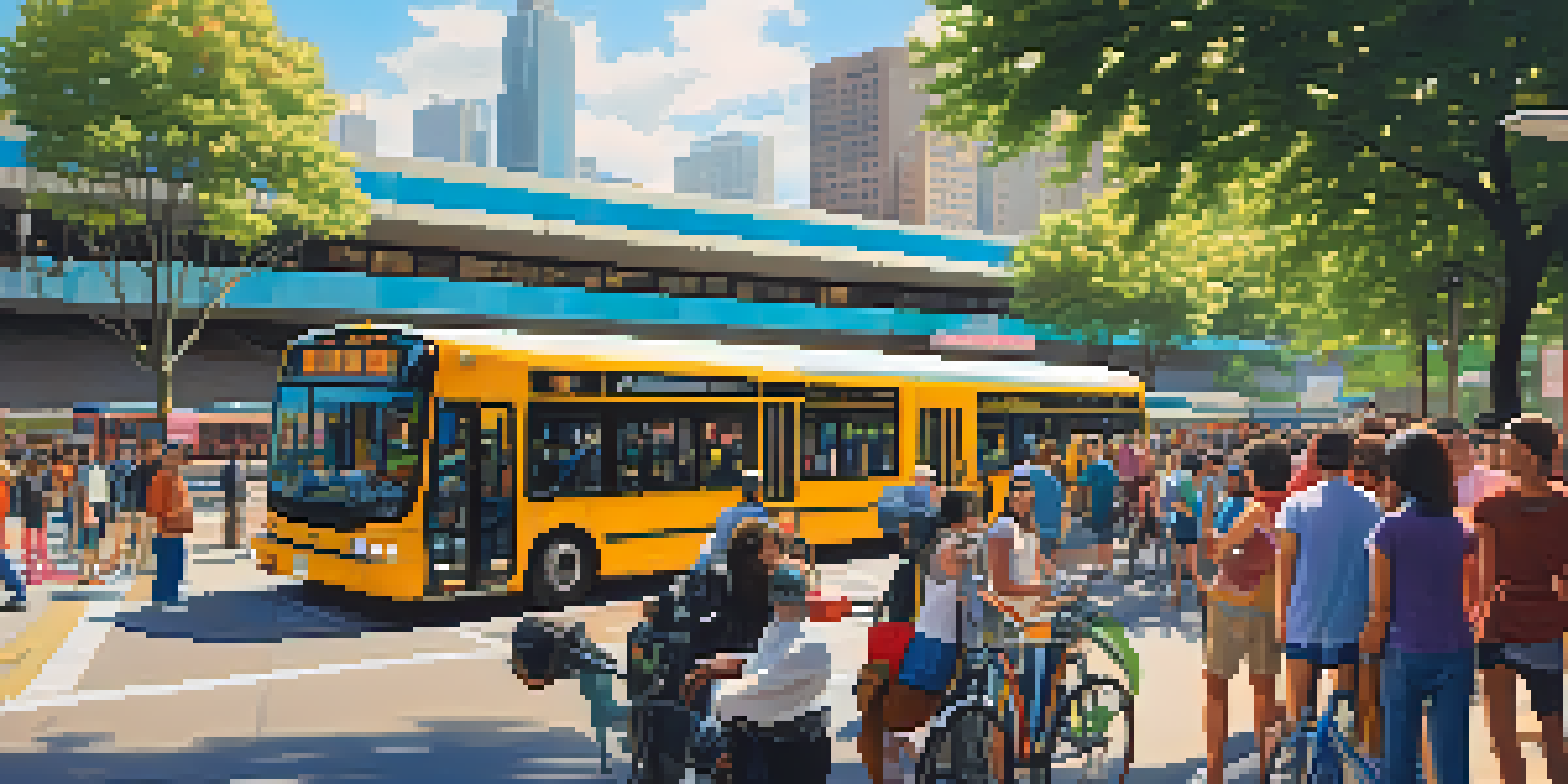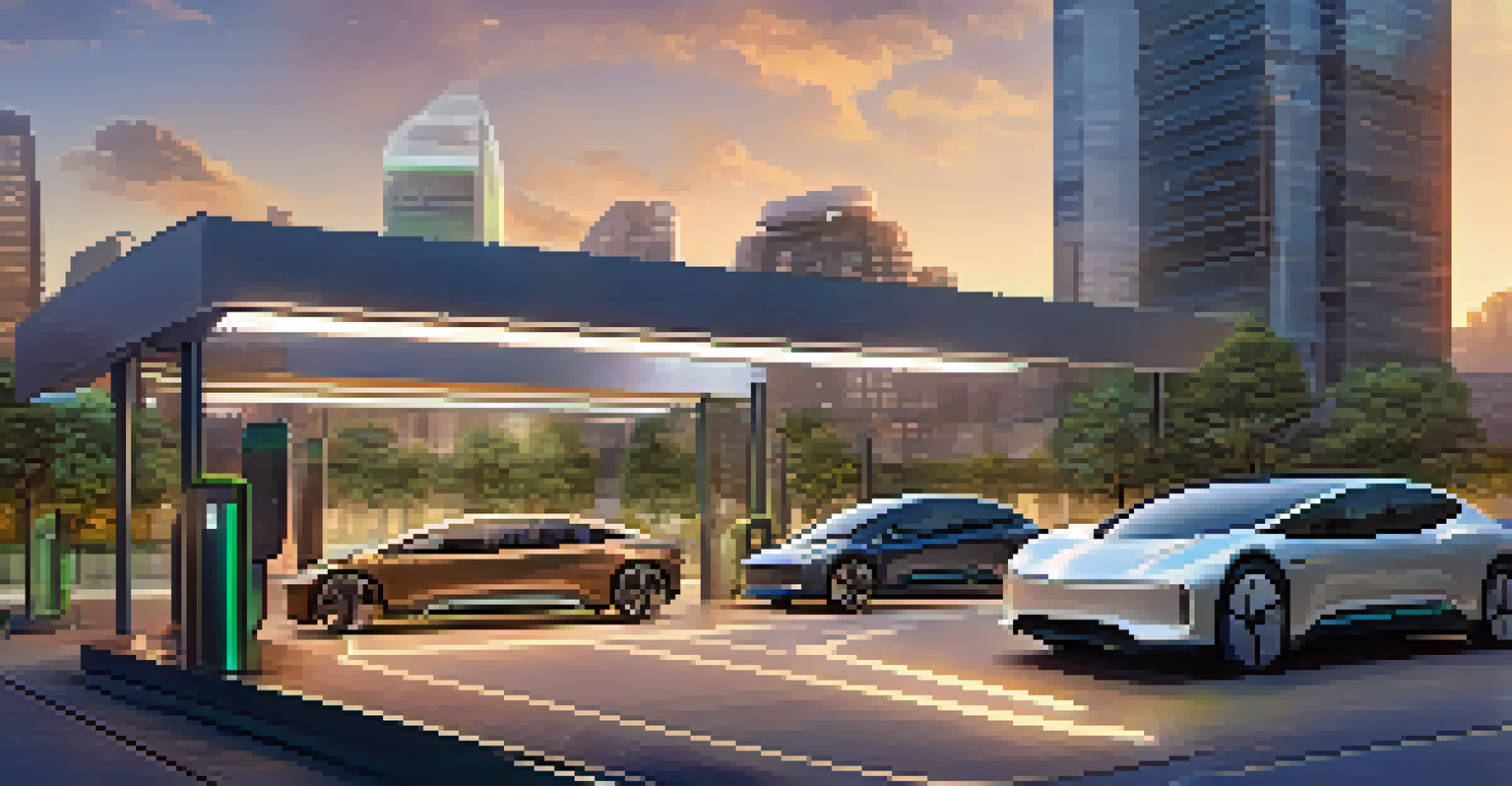Sustainable Transportation: Reducing Urban Carbon Footprints

Understanding Urban Carbon Footprints and Their Impact
Urban carbon footprints represent the total greenhouse gases emitted by a city through transportation, energy use, and more. These emissions significantly contribute to climate change, affecting both the environment and public health. For instance, cities account for a large percentage of global carbon emissions, making it imperative to address this issue.
The greatest threat to our planet is the belief that someone else will save it.
As urban populations continue to grow, the demand for transportation increases, leading to higher carbon outputs. This trend is alarming, as it creates a cycle of pollution that can result in smog, respiratory issues, and even contribute to climate disasters. Recognizing the consequences of our transportation choices is the first step toward sustainable solutions.
By understanding the concept of carbon footprints, we can begin to identify practical ways to reduce these emissions. The shift toward sustainable transportation is not just beneficial for the planet; it enhances urban living conditions, making cities safer and more enjoyable for everyone.
The Role of Public Transportation in Sustainability
Public transportation systems, like buses and trains, are vital in reducing individual carbon footprints. By providing efficient alternatives to personal vehicles, public transport can significantly decrease the number of cars on the road, which in turn reduces traffic congestion and emissions. Imagine a bus carrying 50 passengers instead of 50 cars—it's a simple yet powerful concept.

Investments in reliable public transit infrastructure can encourage more people to use these services. Cities that prioritize public transportation often see a boost in ridership, leading to cleaner air and a lower overall environmental impact. This transition not only benefits commuters but also creates a more connected community.
Urban Areas Contribute to Emissions
Cities are significant contributors to global carbon emissions, necessitating urgent action to address their carbon footprints.
Moreover, the integration of eco-friendly technologies, such as electric and hybrid buses, further enhances the sustainability of public transport. As cities modernize their fleets, they take a significant step toward cleaner urban environments while providing affordable travel options.
Promoting Cycling and Walking for Urban Mobility
Cycling and walking are two of the most sustainable modes of transportation available. Not only do they produce zero emissions, but they also promote healthier lifestyles among urban residents. Imagine a city where biking or walking is the norm—fewer cars mean fresher air and more vibrant public spaces.
Sustainability is no longer about doing less harm. It's about doing more good.
To encourage more people to cycle or walk, cities can invest in dedicated bike lanes and pedestrian-friendly infrastructures, such as wide sidewalks and safe crossings. These improvements make it safer and more inviting for residents to choose non-motorized transportation. Picture a leisurely bike ride through a park instead of sitting in traffic; it's a win-win!
Additionally, community initiatives like bike-sharing programs can make cycling accessible to everyone, regardless of their financial situation. Emphasizing these alternatives not only reduces carbon footprints but also fosters a sense of community and connection among residents.
Electric Vehicles: A Step Towards Cleaner Transportation
Electric vehicles (EVs) are gaining popularity as a sustainable alternative to traditional gasoline-powered cars. These vehicles produce zero tailpipe emissions, which is a significant advantage for urban environments struggling with air quality. Picture cities where the air is clean and the noise pollution from engines is reduced—this is the potential future with EVs.
However, the benefits of electric vehicles extend beyond just emissions. EVs can be powered by renewable energy sources, further decreasing their carbon footprint. As more charging stations become available and battery technology improves, the adoption of electric vehicles will continue to rise, making them a viable option for many.
Public Transport Reduces Carbon Footprint
Investing in efficient public transportation systems can significantly lower individual carbon footprints and improve urban air quality.
To support this transition, governments can provide incentives, such as tax breaks and rebates for EV purchases. By creating an environment conducive to electric vehicle use, cities can take a significant step toward achieving sustainable transportation goals.
Carpooling and Ridesharing: Efficient Urban Travel Solutions
Carpooling and ridesharing are two practical solutions for reducing the number of vehicles on the road. By sharing rides, individuals can significantly decrease their carbon footprints while saving money on transportation costs. It's like splitting the bill at a restaurant; sharing not only makes it cheaper but also more enjoyable.
With the rise of technology, ridesharing apps have made it easier than ever to connect with others who are traveling in the same direction. This convenience encourages more people to opt for shared rides rather than driving alone, leading to fewer cars and less congestion in urban areas. Imagine cities where carpool lanes are bustling with activity instead of being empty—this is the future we can create.
Moreover, promoting community awareness about the benefits of carpooling can foster a culture of shared transportation. As more people recognize the environmental and economic advantages, the transition to sustainable urban travel will gain momentum.
Integrating Technology for Smart Urban Transportation
The integration of technology in transportation systems can lead to more efficient and sustainable urban mobility. Smart traffic management systems, for instance, utilize data to optimize traffic flow, reducing congestion and emissions. Picture a city where traffic lights adjust in real time to minimize idle time—it's a glimpse into the future of urban transportation.
Additionally, apps that provide real-time information on public transport schedules can encourage more people to use these services. When riders can see when the next bus or train is arriving, they're more likely to choose public transit over driving. This seamless integration of technology can make sustainable options more appealing and accessible.
Community Involvement Drives Change
Engaging residents in discussions and initiatives related to sustainable transportation fosters a collective effort toward cleaner urban environments.
Moreover, advancements like autonomous vehicles could also play a role in reducing urban carbon footprints. As these technologies develop and become widely adopted, they hold the potential to revolutionize how we think about and use transportation in cities.
Policy Changes to Support Sustainable Transportation
Policy changes are essential for creating an environment that supports sustainable transportation. Governments can implement measures such as congestion pricing, which charges drivers for entering busy city areas during peak hours. This strategy encourages the use of public transportation and reduces traffic, leading to lower emissions and improved air quality.
Additionally, investing in infrastructure improvements, such as bike lanes and public transport facilities, demonstrates a commitment to sustainable practices. By prioritizing these projects in urban planning, cities can create more livable and eco-friendly environments. Think of it as planting seeds for a greener future; the more we invest now, the more we will reap the benefits later.

Furthermore, engaging the community in discussions about transportation policies can lead to more informed decisions that reflect the needs of residents. By fostering collaboration, cities can develop strategies that effectively reduce carbon footprints while enhancing urban mobility.
The Future of Sustainable Transportation in Urban Areas
The future of sustainable transportation in urban areas is promising, filled with innovative solutions and community engagement. As cities continue to evolve, the integration of green technologies and sustainable practices will shape how we move. Imagine a vibrant cityscape where walking, biking, and public transport are the norm—this is the vision we can work toward.
Community involvement will be crucial in driving this transformation. When residents advocate for and participate in sustainable initiatives, they contribute to a collective effort that can lead to significant change. This grassroots approach not only fosters a sense of ownership but also ensures that the solutions implemented meet the needs of the community.
Ultimately, by embracing sustainable transportation methods, we can create cleaner, healthier, and more connected urban environments. As we look toward the future, it's essential to remember that small changes can lead to monumental impacts, paving the way for generations to come.